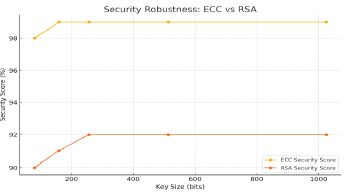Lightweight ECC and Token-Based Authentication Mechanism for IoT
DOI:
https://doi.org/10.26438/ijsrcse.v13i1.611Keywords:
Lightweight Elliptic Curve Cryptography, ECC, LECC, IoT ECC, Token-Based Authentication, Security in IoT, IoT authenticationAbstract
The Internet of Things (IoT) has modernized the latest technology by connecting multiple devices. The limited resources of IoT devices have major challenges in implementing robust security mechanisms. Conversely, cryptographic mechanisms such as RSA & DSA are more expensive, with high energy consumption and high latency values. This research proposes a lightweight authentication mechanism that combines Elliptic Curve Cryptography (ECC) with a token-based approach. The projected result ensures effective authentication, lower computational overhead, and efficient security. Our research experimental assessments determine the projected method's superiority in latency, low energy consumption, and efficient security when compared to traditional authentication methods.
References
Xu M, Fu S, Zhang Q, Jia N, “A verifiable and dynamic multi-keyword ranked search scheme over encrypted cloud data with accuracy improvement”, Social Informatics and Telecommunications Engineering, Vol.254, pp. 588–604, 2018
Susilo W, Chen X., Shen J, Huang X, “An efficient public auditing protocol with the novel dynamic structure for cloud data”. IEEE Transactions on Information Forensics and Security, Vol.12, pp.2402–2415, 2017.
Wang H, Mia X., Liu L, HanG., Jiang J., Peng Y. “A dynamic multipath scheme for protecting source location privacy using multiple sinks in WSNs intended for IIoT.” IEEE Transactions on Industrial Informatics, Vol.16, pp.5527–5538, 2020.
Bayat M, Far H.AN, Das A.K, Pournaghi S.M., Fotouhi M., Doostari M.A., “lightweight anonymous privacy preserving three factor authentication scheme for WSN based IIoT.” Wireless Networks, vol. 27, pp. 1389–1412, 2021.
Alturjman S, Al Turjman F. “Context-sensitive access in the industrial Internet of things healthcare applications.” IEEE Transactions on Industrial Informatics, Vol.14, pp.2736–2744, 2018.
Jain R., Shrivastava A, Verma D, “Performance analysis of cryptographic algorithms RSA & ECC in wireless sensor networks.” IUP Journal of Telecommunications, Vol.7, No.3, pp.15, 2017.
Mansoor K, Baig A.F, Jawad K, Naseem A, Ghani A, “An improved three-factor anonymous authentication protocol for WSN based IoT system using symmetric cryptography.” International Conference on Communication Technologies (ComTech), pp.53–59, 2019.
Lakhlef H, Kandi M.A, Challal Y, Bouabdallah A, “An efficient multi-group key management protocol for the IoT.” 26th International Conference on Software, Telecommunications & Computer Networks (SoftCoM), pp 438–443, 2018.
Warda A, Bhawiyuga A, Data M “Architectural design of token-based authentication of MQTT protocol in constrained IoT device.” 11th International Conference on Telecommunication Systems Services & Applications (TSSA), pp.1–4, 2017.
Messous M.A, Dammak M, Senouci S.M, Boudia O.R.M, Gransart C “Token-based light-weight authentication to secure IoT networks.” 16th IEEE Annual Consumer Communications & Networking Conference (CCNC), pp.825-865, 2019.
Bhuiyan M.Z.A, Li X, Niu J, Karuppiah M, Wu F, Kumari S, “A robust ECC based provable secure authentication protocol with privacy-preserving for IIoT”. IEEE Transactions on Industrial Informatics, Vol.14, No.8, pp.3599–3609, 2018.
Dammak M, Boudia O.R.M, Messous M.A, Senouci S.M, Gransart C, “Token-based lightweight authentication to secure IoT networks” 16th IEEE Annual Consumer Communications and Networking Conference (CCNC). pp.8651825, 2019.
Bhawiyuga A, Data M, Warda A “Architectural design of token based authentication of MQTT protocol in constrained IoT device” 11th International Conference on Telecommunication Systems Services and Applications (TSSA). pp.1–4, 2017.
K. Sonar and H. Upadhyay, “An Approach to Secure Internet of Things Against DDoS.” Singapore: Springer Singapore, pp.367–376,2016.
E. Marin, D. Singelée, B. Yang, I. Verbauwhede, and B. Preneel, “On the feasibility of cryptography for a wireless insulin pump system,” in Proceedings of the 6th ACM Conference on Data and Application Security and Privacy, ser. CODASPY ’16, pp.113–120, 2016.
S. Cirani, M. Picone, P. Gonizzi, L. Veltri, and G. Ferrari, “Iot-oas: An oauth-based authorization service architecture for secure services in Iot scenarios,” IEEE Sensors Journal, Vol.15, No.2, pp.1224–1234, 2015
Jony AI, Arnob AK. “Securing the Internet of Things: Evaluating Machine Learning Algorithms for Detecting IoT Cyberattacks Using CIC-IoT2023 Dataset.” International Journal of Information Technology and Computer Science. 2024.
Nag A, Hassan MM, Das A, Sinha A, Chand N, Kar A, Sharma V, Alkhayyat A. “Exploring the applications and security threats of Internet of Thing in the cloud computing paradigm: A comprehensive study on the cloud of things.” Transactions on Emerging Telecommunications Technologies. 2024.
R. Harkanson and Y. Kim, “Applications of elliptic curve cryptography: A light introduction to elliptic curves and a survey of their applications,” in Proceedings of the 12th Annual Conference on Cyber and Information Security Research, pp.6, 2017.
N. A. Gunathilake, W. J. Buchanan, and R. Asif, “Next generation lightweight cryptography for smart IoT devices: implementation, challenges and applications,” IEEE 5th World Forum on Internet of Things (WF-IoT), pp.707–710, 2019.
B. S. Adiga, P. Balamuralidhar, M. A. Rajan, R. Shastry, and V. L.Shivraj, “An Identity Based Encryption Using Elliptic Curve Cryptography for Secure M2M Communication,” in Proceedings of the 1st International Conference on Security of Internet of Things, ser. SecurIT’12. ACM, pp.68–74, 2012.
S. Arrag, A. Hamdoun, A. B. Tragha, and S. E. Khamlich, “Implementation of Stronger AES by using Dynamic S-Box Dependent of Master key,” Journal of Theoretical and Applied Information Technology ,Vol.53, No.2, 2013

Downloads
Published
How to Cite
Issue
Section
License

This work is licensed under a Creative Commons Attribution 4.0 International License.
Authors contributing to this journal agree to publish their articles under the Creative Commons Attribution 4.0 International License, allowing third parties to share their work (copy, distribute, transmit) and to adapt it, under the condition that the authors are given credit and that in the event of reuse or distribution, the terms of this license are made clear.






